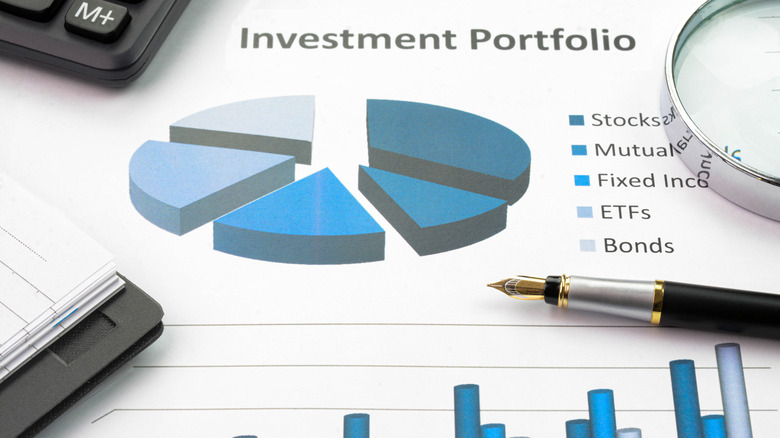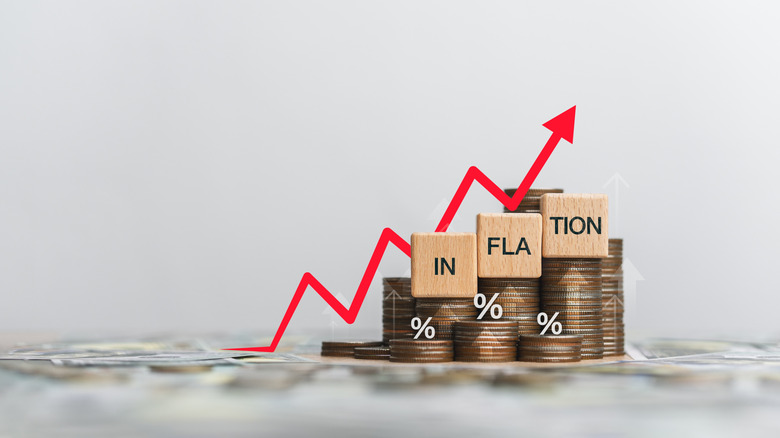12 Risky Investment Mistakes You Should Avoid In 2025
The investment landscape heading into 2025 appears poised for strong growth once again. After numerous turbulent years, led by pandemic-era retractions and then challenges in the tech sector, 2023 and 2024 saw quality growth overall. Investors may be preparing for a similar outcome this year, with analysts predicting more gains. Naturally, you'll want to do your own research to explore what's right for you and your portfolio. However, the market appears to be positioned for quite bullish movement once again.
This leads to a natural secondary set of questions for investors, and particularly those with limited experience in the market. The less you've been subjected to the market's wild whims the more chaotic the environment might seem, leading you astray on your voyage to increased wealth and better financial stability. Mistakes can be found at all corners of an investor's interaction with the stock market (and when getting involved in other asset classes, too). But learning from mistakes and trying to take in the lessons from others can help you avoid catastrophic outcomes. Even if you do pull the trigger on a poor investment opportunity or sell at an inopportune time every once in a while, these allow you to grow as a trader and become more confident in your research chops and investing skills. Mistakes are the bedrock of great traders, and (avoiding) these risky mistakes can act as guiding lights toward a more stable year of growth.
Deciding not to invest this year
The most damaging mistake you can make in your investment journey this year is actually a decision not to invest at all. Failing to invest is a decision that you might make because of other aspects in your financial life taking precedence, or perhaps even a cynicism in your view of the market. But it's one that's a big mistake. Opting not to invest in the market, or any other asset class for that matter, is a missed opportunity that can't be entirely made up later. Of course, sound investment principles will often yield positive results over the long term, but that long-term investment horizon is powered primarily by the tremendous value of time itself. Every year you spend not investing is a year of compound interest appreciation that you can't ever get back.
Failing to invest this year will leave you standing in the same place come December while the market has moved ahead. If you're standing back out of fear, you may just be looking at the wrong sectors or evaluating too short a timeline. Time is your most important ally when investing, and this simple act of actually investing is the best way to put it to work on your behalf.
Pouring all your money into one (or too few) investment(s)
Diversification is always a crucial component in any successful investment strategy. Some investors choose to deliver diversification through singular investments in ETF and other index fund options. These stocks act like a basket of individual companies. Investing in an ETF gives you access to a wide swath of the market because the asset itself holds many other assets. Investing in single companies, on the other hand, provides better upside because an individual brand's success can yield tremendous price appreciation unhindered by the smoothing effect of an ETF that features numerous company holdings.
But, any investment made in a single company is also exposed to greater potential risk. If you pour all of your capital into a single brand and it goes out of business, you'll lose your entire investment. Publicly traded companies don't frequently crater like this, but they can easily shed significant value if a competitor achieves an important breakthrough first or scandal rocks the company's corporate suite. All kinds of negative pressures can drive a stock price down. Without critical diversification featured in your portfolio this can create an outsized impact on your invested cash.
Chasing returns and overextending yourself
Investing in an asset that has recently ballooned in price might seem like a surefire winner. Upward pressure seemingly signals continued momentum and many novice traders might fall for that trap as they continue exploring opportunities in the market. But following the crowd is usually not a great idea. Famous stock traders such as Warren Buffett seek to always bring the highest amount of value into their portfolio. For Buffett, this means remaining ahead of the curve on stock assets that are poised for growth. It's easier said than done, but getting in on a stock ahead of its massive rise in value naturally yields better results than buying a stock that is already expanding.
A great example is GameStop. The upper pressure experienced during the 2021 short squeeze was produced by huge volume of pressure from retail investors on institutional shorts of the company. As the value skyrocketed, it became increasingly volatile. Investors trying to get in on this action not only saw their profit ceiling diminish as the price continued to rise but they also became more and more susceptible to overextension (no one knew exactly where the price ceiling laid). The longer this overinflated price stood the more likely a reversal of its fortunes became. Stocks fluctuate constantly, and any company that is overvalued becomes increasingly vulnerable to a correction. If you're buying far into surging upward momentum, you're exposing yourself to a greater risk of the inevitable fall back to equilibrium.
Investing without a clear plan, target, or goals
Every investor will have some sort of goal or target in mind as they push capital into their portfolio. Some goals are uber-specific, while others remain quite nebulous in nature. Some investors retain long-term targets that are so undefined that they might as well not exist at all. Simply "growing your money" or "investing" isn't good enough when it comes to delivering on a tangible plan. The reason for this lies in the multifaceted landscape of stock market investments. An investor looking to grow their value over time can do so in so many different ways guided by specific value targets, growth timelines, or general goals. Without even the foggiest notion of what you hope to achieve with your investments, you may find it hard to prioritize what kinds of assets to bring into your portfolio.
Those looking for long-term growth, perhaps as a means to eventually purchase their first home or save to send their children to college, might consider investing in index funds and other long-trending growth assets. Someone interested in volatile short term opportunities might seek to take individual stocks or tap into fast moving sectors with research that turns up individual opportunities within the wider marketplace. Your goals drive your strategy so without a clear understanding of what you hope to achieve you'll be running blind.
Ignoring the fees of certain investments or strategies
It's easy to overlook fees and costs in the investment landscape. The cost to work with a financial advisor might be something like 1% or 2% of your total portfolio value or even your annual profit. This doesn't sound like a lot, but the immediate cost levied against your assets isn't the major issue to be concerned with. The same can be said for fees associated with placing trades and even the expense ratio costs associated with mutual funds, ETFs, index funds, and other similar investments.
Anything that costs you money and subtracts from your portfolio extracts a long-term price that only compounds over the months and years standing between the present and your future goals. In the same way that money invested today grows exponentially over time, money lost to transaction fees, brokerage expenses, and other subtractions is capital siphoned from your portfolio that can't grow exponentially — resulting in a sort of exponential loss of earnings potential. If you're trading on a brokerage platform that charges transaction fees, move to a different provider, for starters. Stock market investments have changed radically in the last decade-plus, and no one should be paying to place trades today. Similarly, if you don't make many moves with your portfolio, there's no reason to be paying someone else to manage it, especially funds in a retirement account like a Roth IRA or 401(k).
Ignoring the effects of inflation, tax liabilities, and other costs
Another cost basis easily forgotten is the governmental pressure and economic changes that lie beyond your control. In the same way that making changes to avoid fees that you don't necessarily have to be paying remains a critical step for investors, exploring ways to minimize your tax burden and the negative impact of inflation is critical. Every cost that you incur to invest is something that offsets your overall gains. Tax liabilities and other economic impositions operate in the same realm as direct fees. Unfortunately, many investors forget about this part of the equation when exploring investment opportunities and rebalancing tasks, leaving them susceptible to increased vulnerability.
One area that presents itself most prominently is in selling stocks you've held for less than a year. Capital gains tax on long-held stock positions can be significantly less than tax assessed on shares you've owned for less than a year — as low as 0% in some cases. On the other hand, inflation is a persistent enemy of long-term wealth accumulation. Investing in assets that grow at 4% or less is a recipe for tracking with inflation or possibly even losing money in the grand scheme of things. This is because your dollar figure will grow but the value of those dollars will reduce year over year. Inflation averages at roughly 2% to 3%, but it can go much higher.
Gushing over an investment opportunity or deploying too much emotional cynicism
Becoming emotionally invested in the assets you bring into your portfolio blinds you to the realities of the market. Everything sitting within your portfolio was put there to grow your wealth. Any asset that no longer serves that purpose is one that you should seriously consider cutting loose. This can be challenging for investors who have become attached to certain assets, however. Whether it's a company that you personally like or perhaps even the first company you invested in when you started trading in the stock market, becoming attached to your investments diminishes your ability to think critically about what's best for your money and your future.
The same can be said for overt cynicism about certain assets. It's absolutely acceptable for you to shy away from companies that you don't believe in. While by no means investment advice, a decent example is Boeing. The company has continually suffered from lazy or cost-cutting design flaws that seem to have been entirely preventable, leading to the deaths of passengers and incredibly unsafe flying conditions for others. An emotional investor might decline to buy Boeing shares forever. The company might remain toxic for a very long time, or it might turn back around and offer a quality investment opportunity at some point in the future. Investing emotionally here would close a trader off to future value.
Falling behind on your research
The market is a constantly changing ecosystem that grows and evolves, sometimes in a matter of minutes and other times over years or even decades of glacial progress. Change happens all the time and so investors who are looking to make the most of their time in the market will constantly be working to fill in knowledge gaps. No one can know everything about the stock market's entire scope and breadth, but even more importantly it's impossible to keep up with marketplace trends if you aren't constantly engaging in active research.
Research is the lifeblood of any investor's ability to consistently grow their portfolio. With facts on the ground constantly shifting, an intelligent investor will look to maintain as current in knowledge as possible. If you become complacent and stop researching, you'll fall behind on key details about competitive advantages, new players in the market sector or subspace, and potential challenges to the companies you hold positions in. In short, if you stop reading about developments in the market you will lose the ability to make sound decisions about your current holdings and future acquisitions. You'll be operating on gut instinct rather than fundamental information, leaving you vulnerable to increased levels of risk without added reward.
Trying to time the market
Investing is a marathon rather than a sprint. It's entirely possible to invest in a breakout asset right at the cusp of its success or sell off a large volume of shares right before the stock market craters. But investors who time the market correctly ahead of these kinds of major movements are far luckier than they are good. No one has a crystal ball that can suggest what the market will do. Even major global events like warfare don't impact the market in a singular or even vaguely consistent ways. The reality is that trying to time the market is an exercise in insanity. There's just no way to predict what consumer behavior, price trends, or economic and social conditions beyond the trading floor will do over even a short period of time.
Making the mistake of trying to time the market can lead to severe financial consequences, but more often than not it will simply leave you missing out. Taking a microscopic view of the marketplace and looking to execute specific trades on a specific timeline ensures that you miss the larger picture. Instead, just buying into the market whenever you can with whatever assets you have available will get you on the board. Some trades will be winners and others losers, but keeping money in the market is the best way to enjoy the profits of time and well researched investments. When you invest is far less important than actually doing it.
Reacting to media speculation with too much force
In the same way that following trends leaves you behind on a stock's movement, pulling the trigger on a new buy or sell order because you are reacting to something you saw in the media is even worse. Religiously following advice from media outlets is one more step in the wrong direction when it comes to making intelligent moves that seek to maximize profits. If a company's momentum has gone beyond investor trends and has made its way into the news cycle, this means that you are one additional step behind the money when you react.
Once a company's movement hits the mainstream media, whatever is happening has gone beyond the realm of those following the analytics and entered a realm where everyone has access to the information. Trading at this time makes you a part of the collective masses and means that you won't get the benefit of any kind of first mover advantage and instead have to settle for scraps. By this time, most of the price appreciation on a rapidly growing asset has likely occurred.
Freaking out during market corrections and other down periods
One mistake that novice investors often make involves behavior during a market correction, or worse conditions that devolve into a bear market. When the market is trending sharply downward, people who haven't experienced substantial losses before might be tempted to sell their assets, taking whatever profits they can in the process. It may seem intuitive, as selling while your investments remain above your initial purchase price locks in profits. The problem is that since no one can predict the market accurately, you may be looking at a flash crash in which assets rebound rapidly, leaving you out of your positions and having to buy in at much higher prices.
It's not always a bad idea to sell some of your assets during the market downturn. If you've done your research and expect the market to continue plummeting, selling out of some positions can free up cash that can be used to buy back in at a lower price point. However, it's important to remember that this is a risky maneuver, as prices may rise back up without warning. Experts agree on one thing, during bear market conditions or a correction, investors who can hold their nerve and buy more rather than selling off their assets come through the turbulent trading period drastically better off than those who don't. Sometimes the market flourishes and other times it experiences expansive decline. These cycles are just a part of what it means to be an investor, and freaking out when the market collapses is a great way to lose money, sometimes lots of it.
Making too many trades
Finally, as you enter the new year it's a good idea to evaluate the existing trading strategy you've been deploying and plan to use going forward. Rebalancing your portfolio is always valuable, and heading into the new year offers itself as a solid waypoint for performing these actions. But your portfolio isn't the only thing you should do as you look to the future. Reevaluating how you invest in stocks can offer some valuable insights into maximizing your profits going forward.
One area that many investors get wrong is in trade volume. Making lots of trades is a great way to lose out on long-term value growth. Buying and selling rapidly can reduce your ability to benefit from dividend payouts and more. Unless you are a skilled stock trader, churning through positions with enormous force limits your growth potential and often results in plenty of short term capital gains accumulating on your account. Given a large enough portfolio, this can translate into a substantial tax burden that makes all of those trades worth quite a bit less in the long run. For most investors, the best approach is to play the long game and buy and hold to generate the best possible profits. If you're someone who is often motoring through numerous buy and sell executions, consider slowing down your turnover this year for greater growth with less active effort.












